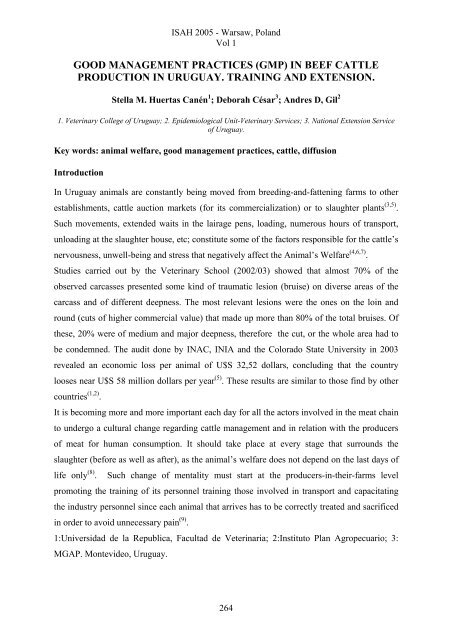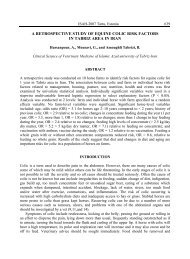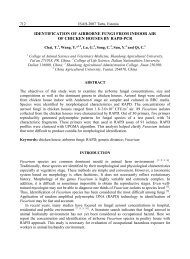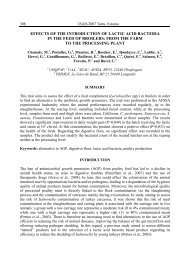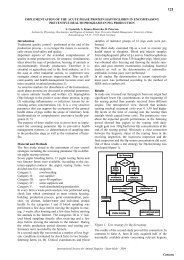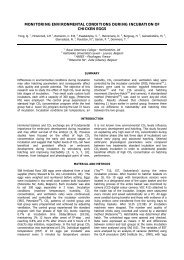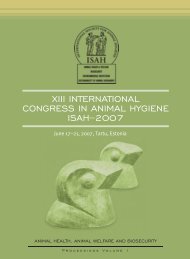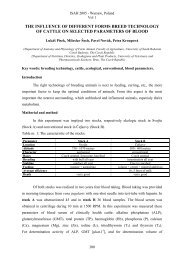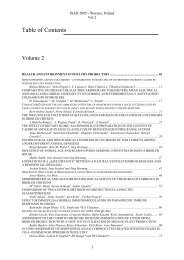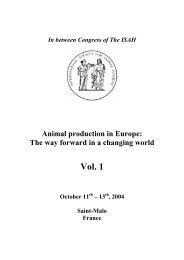(gmp) in beef cattle production - ISAH-SOC
(gmp) in beef cattle production - ISAH-SOC
(gmp) in beef cattle production - ISAH-SOC
Create successful ePaper yourself
Turn your PDF publications into a flip-book with our unique Google optimized e-Paper software.
<strong>ISAH</strong> 2005 - Warsaw, Poland<br />
Vol 1<br />
GOOD MANAGEMENT PRACTICES (GMP) IN BEEF CATTLE<br />
PRODUCTION IN URUGUAY. TRAINING AND EXTENSION.<br />
Stella M. Huertas Canén 1 ; Deborah César 3 ; Andres D, Gil 2<br />
1. Veter<strong>in</strong>ary College of Uruguay; 2. Epidemiological Unit-Veter<strong>in</strong>ary Services; 3. National Extension Service<br />
of Uruguay.<br />
Key words: animal welfare, good management practices, <strong>cattle</strong>, diffusion<br />
Introduction<br />
In Uruguay animals are constantly be<strong>in</strong>g moved from breed<strong>in</strong>g-and-fatten<strong>in</strong>g farms to other<br />
establishments, <strong>cattle</strong> auction markets (for its commercialization) or to slaughter plants (3,5) .<br />
Such movements, extended waits <strong>in</strong> the lairage pens, load<strong>in</strong>g, numerous hours of transport,<br />
unload<strong>in</strong>g at the slaughter house, etc; constitute some of the factors responsible for the <strong>cattle</strong>’s<br />
nervousness, unwell-be<strong>in</strong>g and stress that negatively affect the Animal’s Welfare (4,6,7) .<br />
Studies carried out by the Veter<strong>in</strong>ary School (2002/03) showed that almost 70% of the<br />
observed carcasses presented some k<strong>in</strong>d of traumatic lesion (bruise) on diverse areas of the<br />
carcass and of different deepness. The most relevant lesions were the ones on the lo<strong>in</strong> and<br />
round (cuts of higher commercial value) that made up more than 80% of the total bruises. Of<br />
these, 20% were of medium and major deepness, therefore the cut, or the whole area had to<br />
be condemned. The audit done by INAC, INIA and the Colorado State University <strong>in</strong> 2003<br />
revealed an economic loss per animal of U$S 32,52 dollars, conclud<strong>in</strong>g that the country<br />
looses near U$S 58 million dollars per year (5) . These results are similar to those f<strong>in</strong>d by other<br />
countries (1,2) .<br />
It is becom<strong>in</strong>g more and more important each day for all the actors <strong>in</strong>volved <strong>in</strong> the meat cha<strong>in</strong><br />
to undergo a cultural change regard<strong>in</strong>g <strong>cattle</strong> management and <strong>in</strong> relation with the producers<br />
of meat for human consumption. It should take place at every stage that surrounds the<br />
slaughter (before as well as after), as the animal’s welfare does not depend on the last days of<br />
life only (8) . Such change of mentality must start at the producers-<strong>in</strong>-their-farms level<br />
promot<strong>in</strong>g the tra<strong>in</strong><strong>in</strong>g of its personnel tra<strong>in</strong><strong>in</strong>g those <strong>in</strong>volved <strong>in</strong> transport and capacitat<strong>in</strong>g<br />
the <strong>in</strong>dustry personnel s<strong>in</strong>ce each animal that arrives has to be correctly treated and sacrificed<br />
<strong>in</strong> order to avoid unnecessary pa<strong>in</strong> (9) .<br />
1:Universidad de la Republica, Facultad de Veter<strong>in</strong>aria; 2:Instituto Plan Agropecuario; 3:<br />
MGAP. Montevideo, Uruguay.<br />
264
<strong>ISAH</strong> 2005 - Warsaw, Poland<br />
Vol 1<br />
At national level the importance of this change <strong>in</strong> the way of th<strong>in</strong>k<strong>in</strong>g among the sector has<br />
been understood as well as the necessity of rais<strong>in</strong>g awareness among the whole meat cha<strong>in</strong>. In<br />
2004, the MGAP, through the Agricultural Services Program, approved several projects for<br />
the diffusion and tra<strong>in</strong><strong>in</strong>g of Good Management Practices <strong>in</strong> the rural areas.<br />
The objective was to divulge <strong>in</strong>formation to the different actors of the meat cha<strong>in</strong> (rural<br />
producers, rural employers, <strong>in</strong>termediaries and truck drivers) about Animal Welfare and Good<br />
Management Practices.<br />
Materials and methods<br />
Sem<strong>in</strong>ars of diffusion on Good management practices were organized <strong>in</strong> border and northern<br />
areas of the country. All the actors of the meat cha<strong>in</strong> were <strong>in</strong>vited but special emphasis was<br />
made on the rural employees and on those <strong>in</strong>volved <strong>in</strong> the animal’s periodic handl<strong>in</strong>g. In order<br />
to raise the awareness of every actor on the problem of carcass bruises, several visits to the<br />
slaughterhouses were programmed.<br />
Diffusion brochures were given out to the participants of the sem<strong>in</strong>ars on Good Management<br />
Practices <strong>in</strong> <strong>cattle</strong> farms, load<strong>in</strong>g and transport, and management <strong>in</strong> slaughter plants. The<br />
<strong>in</strong>formation was written <strong>in</strong> simple and easy to understand language. Through a carefully<br />
prepared questionnaire given out to the attendees at the beg<strong>in</strong>n<strong>in</strong>g of the sem<strong>in</strong>ar, data was<br />
obta<strong>in</strong>ed about their <strong>in</strong>frastructure, facilities (condition and characteristics) as well as on the<br />
management of the animals <strong>in</strong> their establishments (persuasive methods, dogs, etc), load<strong>in</strong>g<br />
(type of shipp<strong>in</strong>g facilities, conditions, hours of load<strong>in</strong>g). Such questionnaire also revealed<br />
<strong>in</strong>formation on the characteristics and time of the techniques of management applied (wean,<br />
castration, dehorn<strong>in</strong>g, brand<strong>in</strong>g).<br />
The dynamic of the meet<strong>in</strong>gs went as follows:<br />
The participants were registered and asked to do the questionnaire, then they were given<br />
<strong>in</strong>formative material (brochures). A theoretical presentation followed, supported by<br />
audiovisual material, on the necessity of us<strong>in</strong>g good management practices <strong>in</strong> farms. After<br />
that, practical demonstrations were carried out <strong>in</strong> the <strong>cattle</strong> facilities, putt<strong>in</strong>g emphasis on the<br />
use of flags or other not cruel, persuasive devises to move the animals. The correct<br />
application of vacc<strong>in</strong>es, earr<strong>in</strong>gs or identification tags and of the stamp was also highlighted.<br />
F<strong>in</strong>ally there was a discussion and exchange of experiences stage and participants are asked to<br />
fill an anonymous evaluation form.<br />
265
<strong>ISAH</strong> 2005 - Warsaw, Poland<br />
Vol 1<br />
Regard<strong>in</strong>g the visits to the slaughterhouses, these were carried out <strong>in</strong> small groups; the<br />
reception facilities were visited along with the lairage pens. The group f<strong>in</strong>ally entered the<br />
plant <strong>in</strong> order to observe the carcasses.<br />
Results<br />
The target audience was of nearly 50 participants <strong>in</strong> each of the more than a dozen sem<strong>in</strong>ars<br />
done. Producers of the particular area and their employees, <strong>in</strong>termediaries and truck drivers,<br />
technicians, etc. attended the meet<strong>in</strong>gs. The profile of the partakers, even if with some<br />
variants of little significance, was made up as follows: 50% producers, 30% rural employees,<br />
20% truck drivers and local students.<br />
The anonymous evaluations qualified the sem<strong>in</strong>ar as: Very Good 54%, Good 45%; there was<br />
no evaluation that considered the meet<strong>in</strong>g as Bad. With regards to the support material handed<br />
out, 60% of the participants found it to be Good and 34% Very Good. In terms of the practical<br />
application of the discussed topics, 73% of the attendees judged them as Very applicable.<br />
Discussion and conclusion<br />
Once the ethical grounds for Animal Welfare were understood, <strong>in</strong> addition to the economic<br />
losses <strong>in</strong>adequate <strong>cattle</strong> handl<strong>in</strong>g represents, the participants showed great enthusiasm and<br />
excellent disposition as well as a constructive attitude and will<strong>in</strong>gness to change certa<strong>in</strong><br />
traditionally used practices.<br />
The jo<strong>in</strong>t effort of several groups of veter<strong>in</strong>arians, the syndicate associations along with<br />
technicians from the Veter<strong>in</strong>ary School and the extension services of Uruguay made possible<br />
the achievement of the objectives. Moreover, an important change of mentality can be<br />
perceived that will enable the country to enter more exigent markets with very high quality<br />
meat and respect<strong>in</strong>g the Animal Welfare.<br />
References<br />
1. Boleman,L., Boleman J., Morgan W, et al. National Beef Quality Audit-1995: Survey of Producer-Related<br />
Defects and Carcass and Quality Attributes J. Anim Sci. 1998 76:96-103<br />
2. Donkersgoed, J.V., Jewison G., et al. Canadian Beef Quality Audit. Can. Vet. J. 2001, 42:121-126<br />
3. Fikuart K.,Hollewen K., Kuhn G., Práctica e Higiene del Transporte de Animales. Zaragoza; Acribia,<br />
1995. 154p.<br />
4. Grand<strong>in</strong> T Livestock Handl<strong>in</strong>g and Transport. 2 nd Edition CABI Publ.Wall<strong>in</strong>gford Oxon,UK, 2000.<br />
5. INAC-INIA-CSU. Auditoría de la carne vacuna, Uruguay, 2003<br />
6. Knowles T.G. A review of the road transport of <strong>cattle</strong>. Vet. Record 1999, 144:197-201<br />
7. Marshall, B.L. Bruis<strong>in</strong>g <strong>in</strong> <strong>cattle</strong> presented for slaughter. N.Z. Vet. J.1976, 25:83-86<br />
8. McNally P.W., Warris P.D. Recent bruis<strong>in</strong>g <strong>in</strong> <strong>cattle</strong> at abattoirs. Vet. Record 1996, 138, 126-128.<br />
9. Warriss,P. The handl<strong>in</strong>g of <strong>cattle</strong> pre-slaughter and its effects on carcass and meat quality. Applied Animal<br />
Behavior Sci. Amsterdan 1990, 28:171-186.<br />
266


